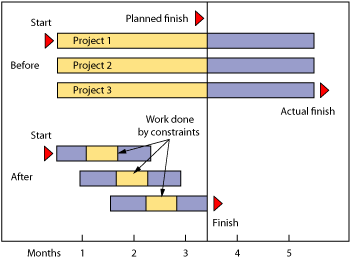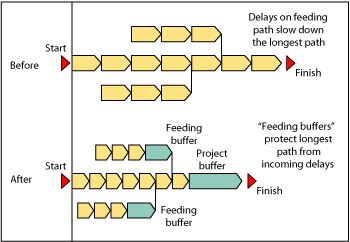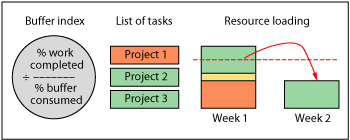Project execution management can dramatically increase profits and accelerate cash flow for all participants in the infrastructure supply chain.
Sanjeev Gupta, Realization Technologies
The rising worldwide demand for oil and gas and resultant higher energy prices have intensified the search for new oil and gas reservoirs over the past few years. This has greatly boosted demand for infrastructure such as drilling rigs, production platforms, FPSOs, crane vessels, pipe layers and support vessels. Backlogs are at record levels, and delivery lead times keep getting longer.
Oil industry revenues today are constrained not by poor demand or low prices, but by lack of infrastructure to capitalize on the increasing demand and high prices. Rig operators as well as builders are looking for solutions that will let them accelerate deliveries of newbuilds and other infrastructure items.
However, adding design, fabrication, assembling and commissioning capacity itself can take months, if not years, and the required capital investments carry risk because of the volatile political environment. A better solution may lie in more effective execution of projects.
PROJECT EXECUTION MANAGEMENT
It can often take 12-15 months to design a first-in-class rig and18-24 months to build a jackup. The business benefits of cutting such projects by 6 months or more can be substantial. Not only would it accelerate the rig’s availability to the operators, but it would also free up manufacturing capacity earlier to start the next project. By improving their execution, equipment manufacturers with severe backlogs have a significant opportunity to enhance their bottom line.
Project execution management has been adopted by engineering organizations and project manufacturers around the world to shorten delivery times by 20-30% and increase productivity by 15-20%. While not a panacea, it can dramatically increase profits and accelerate cash flow for all participants in the infrastructure supply chain.
Execution management’s goal is to keep projects flowing-synchronizing parallel activities in a project, allowing resources to be concentrated on the right projects at the right time and providing early warning signals so that emerging issues are resolved before they threaten project completion, not after the fact.
UNCERTAINTIES CREATE CHALLENGES
The supply chains for designing, fabricating, assembling and commissioning rigs and specialized machinery are complex, riddled with uncertainties. Many different types of subassemblies are required, on which many different groups must work, often in different locations. Steel might be cut in one facility, sent to another for fabrication and, then, sent to yet another location. Most of the time, the various facilities are not synchronized with each other. Each is operating to the pulse of its own pressures and delivery requirements.
Parts must be ordered to create the new order’s subassembly, yet there are always parts shortages, and some parts have long lead times. Adjustments (“work-arounds”) must be made when vendors don’t deliver as planned. Customer approvals needed at various completion points may add to the delays, forcing fabrication or design to wait. Customer specifications may change during execution, and technical problems are often found. These uncertainties result in delays, disrupting original schedules.
In addition, groups working on the same project compete for limited resources-engineers, fabricators, assemblers, barges and trucks to transport, mechanics, facilities, tools and equipment. Components for the subassembly may come from outsourcers. Since they support multiple customers, there is tremendous competition for their capacity. All too often, only “the squeakiest wheel gets the grease.”
As uncertainties strike during execution, plans go awry. Priorities become unclear. Every successive operation inherits the delays, passing them along with their own delays to the next group. Resources are constantly pulled from one project to fix other projects’ problems. The result is not surprising. Delays and other problems break out all over, and the total time taken is much more than needed for the real work content.
MANAGING UNCERTAINTIES
Standard management practices and methods worsen the impact of uncertainties.
“Start ASAP” causes late completion. Experienced managers intuitively know the devastating effects of uncertainties and competition for resources. Managers facing tight deadlines feel tremendous pressure to start new projects or work packets within projects as soon as possible. Once a project arrives, there is pressure to get it going right away.
This “start ASAP” mode fosters much work, dramatically increasing competition for limited resources. Engineers, fabricators, assemblers, installers and other resources get spread thin, moved from one task to another without completing the current task. The resultant multitasking has a devastating impact on schedules and productivity. Tasks simply take much longer than they should.
“Start ASAP” also creates multitasking between current backlogs and new sales. The sales department wants to bring in new orders, while operations managers, in order to keep their workforce active, call on engineering to “get us work, any work.” Thus, engineering becomes caught between the rock of supporting new sales and the hard place of creating projects for the upstream workforce, just to keep them busy.
Delays worsen, creating even more pressure to start ASAP. This vicious cycle results in an operation where there is too much Work In Progress (WIP), constant fire-fighting and frustration. Despite hard work, expediting and overtime, projects run late, cycle times are long, productivity is low and costs remain high.
Yet, the heavier the workload and the more urgent the projects, the higher the tendency to start work ASAP, and the worse the situation becomes.
Poor measurements delay execution. To gain control, managers insert hard dates (artificial milestones) in the schedule and hold people accountable for not meeting those due dates. Yet, setting hard dates in an uncertain environment only makes people add “buffers” in their estimates. Frowned upon, these buffers are “hidden” and vigorously justified if questioned. Unfortunately, these buffers get wasted in execution as “Parkinson’s Law” (putting off work until it becomes urgent or continuing to polish already finished work) sets in. Work rarely finishes early.
But that’s not all. Traditional measurements also encourage the execution of easy tasks that do not lie on the critical path, rather than the ones that are critical but difficult. It’s human nature. If you have five tasks to do and No. 3 is the easiest, which one will you do first? Over and over, people are “encouraged” to open and work on new tasks instead of solving problems on their current ones. As these open tasks begin to pile up, managerial and problem-solving bottlenecks begin to form and bog down the entire project. In project execution, this tendency to work on the easiest tasks also leads to quality problems, by tempting project participants to do tasks out of sequence.
Lack of task priorities turns managers into firefighters. Organizations have invested much time and money implementing detailed planning and tracking systems to give them “visibility.” Unfortunately, these systems only provide after-the-fact reports; they do little to improve the pace and productivity of execution.
To avoid multitasking, what frontline supervisors really need are clear, task-level priorities, within and across projects. These priorities should be stable and undisputable. Moreover, they should also highlight the tasks that are highly urgent, so that managers can focus their attention and take extraordinary actions where needed.
Similarly, project managers and senior managers need early warning signals at the project level. They should be able to spot problems that threaten project completion, ahead of time and not after the fact.
SHOULD WE ACCEPT THE STATUS QUO?
The bottom line is that standard management practices and methods reinforce the impact of uncertainties, causing much waste. What oil producers and oil equipment manufacturers want, especially with an increase in drilling opportunities on the horizon and an inability to hire qualified people quickly enough, is to eliminate all this wasted time and capacity. They want to deliver their current backlog of orders and expose capacity for additional business.
The question is, “What are the new management practices and methods we need to avoid this waste?”
NEW RULES TO SYNCHRONIZE EXECUTION
The new rules run counter to standard methods but make good sense.
Stagger projects based on most limited resources. WIP in the system is carefully regulated based on how much work the bottleneck resources can handle. An analogy is the metering lights that control the release of cars into a crowded freeway.
When projects are metered in this way, resources throughout the supply chain can concentrate without multitasking. Works flows smoothly, problems are found and resolved quickly, and parts arrive for assembly in a synchronized fashion.
Not starting new projects ASAP also gives organizations the time to do necessary preparations ahead of execution, Fig. 1. As they say, “Well begun is half done.”
 |
|
Fig. 1. Since a project pipeline can only carry out as many tasks as it can get through its weakest constraint, releasing more work than the constraint can handle only results in work piling up in front of the constraint.
|
|
Don’t turn local task estimates into commitments. When people know that estimates will not be turned into commitments, they typically give tighter estimates. However, these tight estimates are not used to promise due dates to the customer. Instead, the due date is protected by a “time buffer” at the end of the project that will absorb all delays that will occur due to uncertainties. These buffers are more efficient not only because they are visible, but also because they are aggregated; some tasks will use the buffers and others will not.
Instead of each department working to its own local date, they all work toward the only date that matters-the customer delivery date, Fig. 2.
 |
|
Fig. 2. Hidden safeties should be replaced with explicit buffers either at the end of the project or just before integration points for individual tasks. These latter buffers will act as shock absorbers, protecting the project against any single task running too late.
|
|
Monitor buffer consumption to prioritize tasks. Resources should be assigned to tasks in a systematic fashion without multitasking them or spreading them thin. Tasks that consume their buffer the most often will then be given the highest priority. Engineers and crews work on only one task at a time and are given the next task based on the priority order, only after the current task is completed. Planners and expeditors are also focused and not spread thin. They follow the same set of priorities to ensure that their tasks are fully ready before execution.
Since the entire organization works toward the same set of priorities, synchronization improves, work flows much more quickly than before and productivity increases. Consumption of buffers also provides early warning signals to managers so they can react before problems worsen, Fig. 3.
 |
|
Fig. 3. Highest priority should be given to the tasks that have the smallest buffers ahead of them. Recovery actions should be initiated if the remaining buffers fall below a certain threshold.
|
|
As a result of employing the above three rules, a drilling manufacturer is finally able to leverage exposed capacity to increase the rate of delivered programs, keeping the supply chain for both design and material synchronized to the yard. Empahsis shifts to days instead of man-hour consumption.
Importantly, to make all this happen, key management policies as well as style may need to change. By going from a “how to fight fires” to a “how to manage” scenario, the organization can keep the noise from both downstream and upstream work centers down while building product faster.
INSTITUTIONALIZING THE NEW RULES
Putting the new rules in place and sustaining them requires implementation of a complete execution management system, which is comprised of:
Operational goals and measurements to achieve business goals. Operational goals include targets for cycle time reduction and improvements in throughput and due-date performance plus measurements that promote execution according to synchronized priorities and early warning signals.
Management policies and processes to enforce the new rules, as well as to translate these rules into decisions and actions readily understood by all.
Execution-oriented project plans with enough detail to provide good execution priorities, but not so detailed that control becomes difficult.
Enabling software that helps managers prioritize and meter the release of new projects, put buffers in the right place, and that synchronize day-to-day priorities and alert managers to potential problems.
WHAT ARE THE RESULTS?
Drilling rig manufacturers are reporting that project execution management provides increased revenue opportunities. For instance, one organization completed the design engineering of a first-class rig in 35% less time, going from a previous 15-month engineering time to just 9 months, picking up 6 months of extra capacity.
In product engineering, a hull structure design was completed in 44% less time, dropping from 9 months to 5 months. Why? Hull construction is no longer impeded by engineering. Event schedules are determined by capacity in the yard and buffer signals, not subjective due dates. Perhaps just as importantly, such a process removes the conflict in scheduling between sister locations, letting each locality make good resource decisions based on its capacity and overall synchronization.
It’s not just engineers and manufacturers in the oil industry that are benefiting from this new approach. Organizations in sectors as varied as high-tech product development, construction, aircraft maintenance and repair, steel mill maintenance and repair, and even satellite design and construction have reported impressive gains in project speed and throughput. In fact, the US Air Force Warner Robins Air Logistics Center won the prestigious 2006 Franz Edelman award for saving $2.37 billion in aircraft replacement costs by accelerating the maintenance and repair of C-17 aircraft using this new approach.
Results such as these indicate how important it is for drilling rig and platform manufacturers to make project execution management part of their bottom-line solution. 
|
THE AUTHOR
|
|
|
Sanjeev Gupta is CEO of Realization Technologies, the pioneer and leading provider of execution management solutions to more than 200 companies. Prior to Realization, he was CEO of Thru-Put Technologies, a supply chain management solutions provider. He has an MS degree in public management and policy from Carnegie Mellon University, an MS degree in mechanical engineering from Virginia Tech and a degree in mechanical engineering from the Indian Institute of Technology-Delhi.
|
|
| |
|
|






